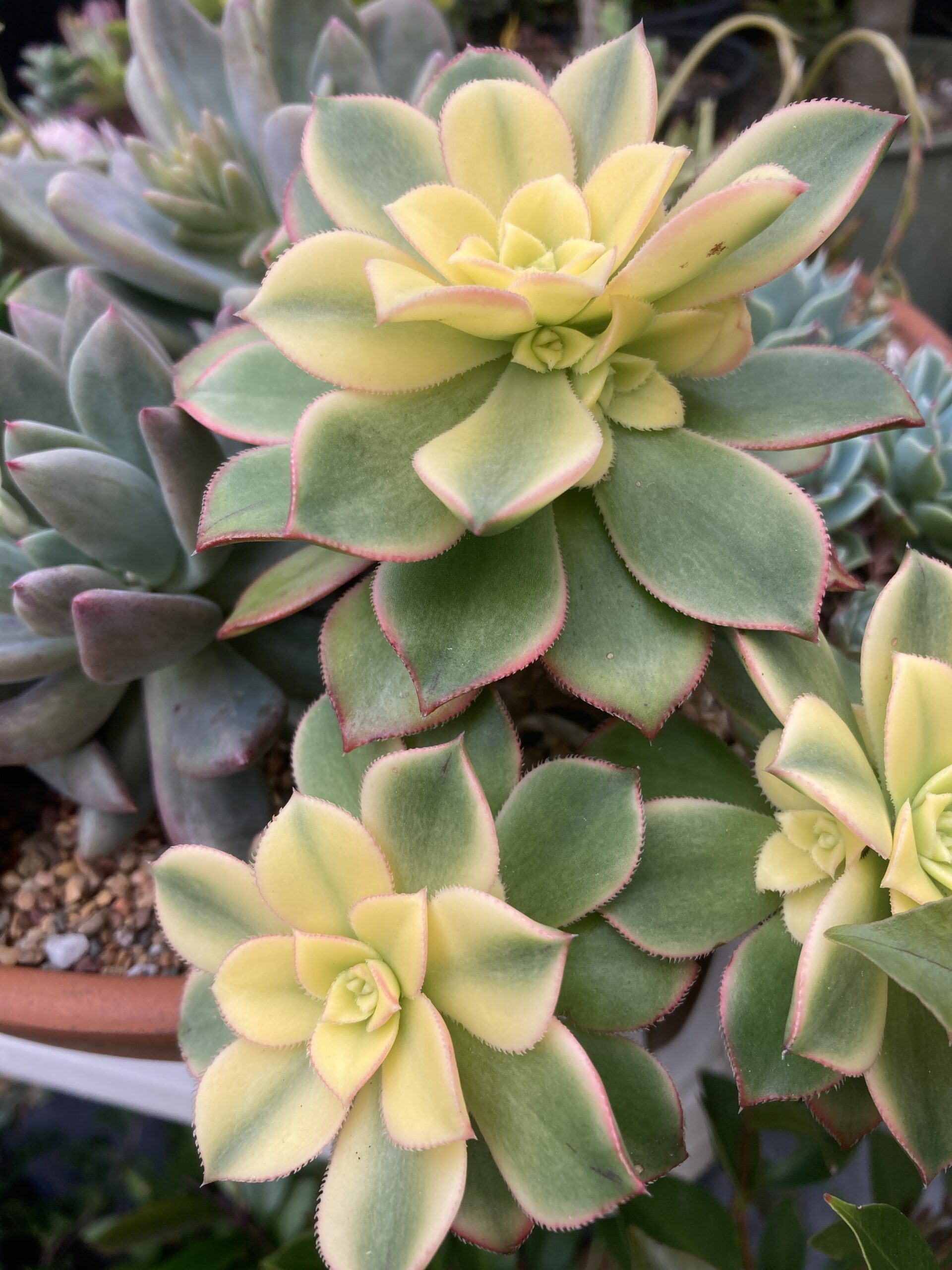Your cart is currently empty!

Aeonium Haworthii Kiwi Care & Propagation
Aeonium haworthii ‘Kiwi’/ ‘Dream Colour’ is a hybrid succulent plant from the family Crasaulaceae. It is a very popular succulent due to its showy, tricolour leaves forming a pretty rosette.
Description
Aeonium Kiwi grows as a small sized shrub with the main stem branching out and ending in a rosettes type arrangement. Each rosette can measure up to 15-20 cm, depending on conditions it’s grown in.
Plants in shade can measure wider and grow longer leaves whereas plants in full sun will be more compact and smaller. This cultivar usually grows to approximately 50cm height and width. The leaves are green, yellow and pink with a pointy end. Plants grown in the shade tend not to develop the pink edges that the sun grown plants have. Young rosettes form in a circle around more mature rosettes and eventually branch out.
The flowering of this plant can be random, depending on the age and location of the plant. Most of the time Aeonium Kiwi can flower in late winter-early spring.
A cone of yellow flowers will grow out of the centre of the rosette. The flowers last for approximately a month then the rosette will die. The flower spike, including the rosette it is shooting out off can be cut down completely. It is unlikely the whole plant will die when flowers appear, only the rosettes that have flowered.
Propagation
Aeonium Kiwi easily propagates by cuttings. While leaves can be propagated, they are very difficult to raise to a full-size plant and often die after leaf babies are a 2-3 months old. Seed propagation is possible but also hard and very slow.
The best time to propagate is in early spring. As with most Aeoniums, Aeonium Kiwi is a summer dormant plant and difficult to propagate during the summer months.
After cutting an offset or a branch, leave in a shaded, dry spot for about 24 hours and then plant either directly in the garden or in succulent potting mix in a pot. Keep in shaded, but very bright spot with a bit of morning sun to maintain the colour and hardiness of the plant. Roots should appear in 3-4 weeks.
Position & Care
Aeonium Kiwi is a hardy plant that can withstand poor soil and a range of temperatures. It is not frost hardy and will freeze and die if exposed to temperatures below 0 degrees Celsius (32 F). If grown in a climate where frost and snow is common in winter, this plant should be grown in pots and brought indoors until the danger of frosts passes.
The best position for this plant is morning sun, however, it can also be grown in full sun and bright shade. Plants in shade will grow larger, longer leave with less colour and plants in sun will grow compact and brilliant vibrant yellow, green and pink.
Aeonium Kiwi is suitable to plant in the garden as well as in pots, though the pot should be fairly big. Pot plants should be kept in afternoon shade during heatwaves over 35 C (95F). Plants in the ground should cope with these temperatures as their root system can stay cool.
For best result, water this plant when the potting mix/soil has dried up. Aeonium Kiwi will cope with droughts, but to prevent soil becoming hydrophobic, it should be watered regularly.
Aeoniums are dormant in summer and grow in the cooler months, unlike most other succulents. It is best they are left alone in summer, though they will need to be watered when temperatures rise.
We have had many questions about Aeonium Kiwi developing brown spots or lines on their leaves. We grow many of these plants both in pots and in the garden and have found the brown leaves can be caused by heat stress, too much water & high humidity and fungus.
Unfortunately it is very hard to completely avoid these brown spots especially if the Kiwi is grown outdoors, which it usually needs to be. The good news is that the brown spots tend to grow out on their own.
Fungus is never a good thing though, so just to be on the safe side, the plants can be sprayed with natural fungicide during rainy periods. To prevent brown spots caused by heat, keep plants in shade on hot days or put under 30% shadecloth. Dormant plants can be moved to bright shade/ filtered light in summer to prevent further sun damage.
Pests
Aeonium Kiwi, especially if grown in pots, is susceptible to mealy bugs and aphids.
Mealy bugs can either hide in-between the leaves, close to the stalk or attack the root system.
Aphids often appear when the weather starts warming up in early spring and are more easily spotted as they tend to attack the centre of the rosettes, though, sometimes can also hide on the undersides of the leaves.
Caterpillars and snails are also known to feed on aeonium leaves.
Where Can I Buy It
Aeonium Kiwi should be easy to come by and inexpensive. These plants are quite common and usually available in most garden centres, nurseries or online succulent nurseries.